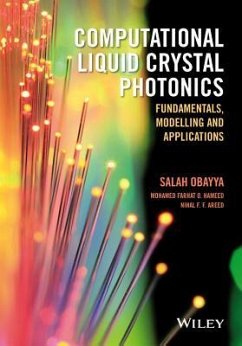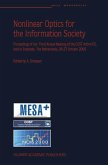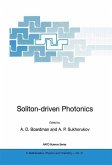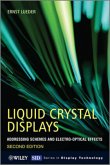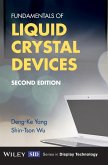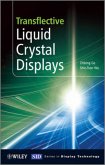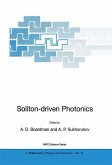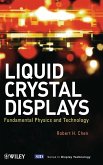Salah Obayya, Mohamed Farhat O Hameed, Nihal F F Areed
Computational Liquid Crystal Photonics
Fundamentals, Modelling and Applications
Salah Obayya, Mohamed Farhat O Hameed, Nihal F F Areed
Computational Liquid Crystal Photonics
Fundamentals, Modelling and Applications
- Gebundenes Buch
- Merkliste
- Auf die Merkliste
- Bewerten Bewerten
- Teilen
- Produkt teilen
- Produkterinnerung
- Produkterinnerung
"Optical computers and photonic integrated circuits in high capacity optical networks are hot topics, attracting the attention of expert researchers and commercial technology companies. Optical packet switching and routing technologies promise to provide a more efficient source of power, and footprint scaling with increased router capacity; integrating more optical processing elements into the same chip to increase on-chip processing capability and system intelligence has become a priority. This book is an in-depth look at modelling techniques and the simulation of a wide range of liquid…mehr
Andere Kunden interessierten sich auch für
![Nonlinear Optics for the Information Society Nonlinear Optics for the Information Society]() Nonlinear Optics for the Information Society77,99 €
Nonlinear Optics for the Information Society77,99 €![Soliton-driven Photonics Soliton-driven Photonics]() BoardmanSoliton-driven Photonics161,99 €
BoardmanSoliton-driven Photonics161,99 €![Liquid Crystal Displays Liquid Crystal Displays]() Ernst LuederLiquid Crystal Displays168,99 €
Ernst LuederLiquid Crystal Displays168,99 €![Fundamentals of Liquid Crystal Devices Fundamentals of Liquid Crystal Devices]() Deng-Ke YangFundamentals of Liquid Crystal Devices155,99 €
Deng-Ke YangFundamentals of Liquid Crystal Devices155,99 €![Transflective Liquid Crystal Displays Transflective Liquid Crystal Displays]() Zhibing GeTransflective Liquid Crystal Displays130,99 €
Zhibing GeTransflective Liquid Crystal Displays130,99 €![Soliton-driven Photonics Soliton-driven Photonics]() BoardmanSoliton-driven Photonics161,99 €
BoardmanSoliton-driven Photonics161,99 €![Liquid Crystal Displays Liquid Crystal Displays]() Robert H. ChenLiquid Crystal Displays130,99 €
Robert H. ChenLiquid Crystal Displays130,99 €-
-
-
"Optical computers and photonic integrated circuits in high capacity optical networks are hot topics, attracting the attention of expert researchers and commercial technology companies. Optical packet switching and routing technologies promise to provide a more efficient source of power, and footprint scaling with increased router capacity; integrating more optical processing elements into the same chip to increase on-chip processing capability and system intelligence has become a priority. This book is an in-depth look at modelling techniques and the simulation of a wide range of liquid crystal based modern photonic devices with enhanced high levels of flexible integration and enhanced power processing. It covers the physics of liquid crystal materials; techniques required for modelling liquid crystal based devices; the state-of-the art liquid crystal photonic based applications for telecommunications such as couplers, polarization rotators, polarization splitters and multiplexer-demultiplexers; liquid core photonic crystal fiber (LC-PCF) sensors including biomedical and temperature sensors; and liquid crystal photonic crystal based encryption systems for security applications. Key features Offers a unique source of in-depth learning on the fundamental principles of computational liquid crystal photonics. Explains complex concepts such as photonic crystals, liquid crystals, waveguides and modes, and frequency- and time-domain techniques used in the design of liquid crystal photonic crystal photonic devices in terms that are easy to understand. Demonstrates the useful properties of liquid crystals in a diverse and ever-growing list of technological applications. Requires only a foundational knowledge of mathematics and physics. "--
Hinweis: Dieser Artikel kann nur an eine deutsche Lieferadresse ausgeliefert werden.
Hinweis: Dieser Artikel kann nur an eine deutsche Lieferadresse ausgeliefert werden.
Produktdetails
- Produktdetails
- Verlag: Wiley
- Seitenzahl: 272
- Erscheinungstermin: 31. Mai 2016
- Englisch
- Abmessung: 244mm x 170mm x 18mm
- Gewicht: 612g
- ISBN-13: 9781119041955
- ISBN-10: 1119041953
- Artikelnr.: 44789986
- Herstellerkennzeichnung
- Libri GmbH
- Europaallee 1
- 36244 Bad Hersfeld
- gpsr@libri.de
- Verlag: Wiley
- Seitenzahl: 272
- Erscheinungstermin: 31. Mai 2016
- Englisch
- Abmessung: 244mm x 170mm x 18mm
- Gewicht: 612g
- ISBN-13: 9781119041955
- ISBN-10: 1119041953
- Artikelnr.: 44789986
- Herstellerkennzeichnung
- Libri GmbH
- Europaallee 1
- 36244 Bad Hersfeld
- gpsr@libri.de
Salah S. A. Obayya, Zewail City of Science and Technology, Giza, Egypt Professor Salah Obayya developed for his PhD a novel finite element-based full-vectorial-beam-propagation algorithm for the analysis of various photonic devices. He worked as a Senior Research Fellow at the School of Engineering, City University London. From June 2003 until Sept. 2006, he joined the School of Engineering and Design, Brunel University, West London, U.K., to work as a Senior Lecturer, followed by a Readership at The School of Electronic and Electrical Engineering, University of Leeds. Professor Obayya is now Full Professorial Chair of Photonics and led the establishment of the "Nano-Photonics Research Centre" at The University of Glamorgan, UK, while he is now Full Professor of Photonics and Director of Centre for Photonics and Smart Materials at Zewail City of Science and Technology. Mohamed Farahat O. Hameed, Zerwail City of Science and Technology, Giza, Egypt Dr Mohamed Farahat O. Hameed was a member of Prof. Obayya photonics group at Leeds University, South Wales University, UK, and now Zewail City, contributing in the design and analysis of a wide range of liquid crystal based photonic devices such as polarization splitter, polarization rotators, couplers, multiplexer-demultiplexers, and sensors. Nihal F. F. Areed, Zerwail City of Science and Technology, Giza, Egypt Associate Professor Nihal Areed is a lecturer at Electronics and Communications Dept., Faculty of Engineering, Mansoura University, Mansoura, Egypt. She obtained her PhD degrees in Electronics and Communications Engineering from Mansoura University, Egypt. Her main research interests are focused on the fields of electromagnetics and photonics, in particular in the area of modelling, design and numerical simulation of nanophotonic devices.
Preface xv Part I Basic Principles 1 1 Principles of Waveguides 3 1.1 Introduction 3 1.2 Basic Optical Waveguides 4 1.3 Maxwell's Equations 6 1.4 The Wave Equation and Its Solutions 7 1.5 Boundary Conditions 9 1.6 Phase and Group Velocity 10 1.6.1 Phase Velocity 10 1.6.2 Group Velocity 11 1.7 Modes in Planar Optical Waveguide 12 1.7.1 Radiation Modes 13 1.7.2 Confinement Modes 13 1.8 Dispersion in Planar Waveguide 13 1.8.1 lntermodal Dispersion 14 1.8.2 lntramodal Dispersion 14 1.9 Summary 15 References 15 2 Fundamentals of Photonic Crystals 17 2.1 Introduction 17 2.2 Types of PhCs 18 2.2.1 1D PhCs 18 2.2.2 2D PhCs 19 2.2.3 3D PhCs 21 2.3 Photonic Band Calculations 21 2.3.1 Maxwell's Equations and the PhC 22 2.3.2 Floquet-Bloch Theorem, Reciprocal Lattice, and Brillouin Zones 23 2.3.3 Plane Wave Expansion Method 26 2.3.4 FDTD Method 29 2.3.4.1 Band Structure 29 2.3.4.2 Transmission Diagram 30 2.3.5 Photonic Band for Square Lattice 30 2.4 Defects in PhCs 31 2.5 Fabrication Techniques of PhCs 32 2.5.1 Electron-Beam Lithography 32 2.5.2 Interference Lithography 33 2.5.3 Nano-Imprint Lithography 33 2.5.4 Colloidal Self-Assembly 34 2.6 Applications of PhCs 34 2.7 Photonic Crystal Fiber 35 2.7.1 Construction 35 2.7.2 Modes of Operation 36 2.7.2.1 High Index Guiding Fiber 36 2.7.2.2 PBG Fibers 36 2.7.3 Fabrication of PCF 37 2.7.4 Applications of PCF 37 2.8 Summary 37 References 37 3 Fundamentals of Liquid Crystals 41 3.1 Introduction 41 3.2 Molecular Structure and Chemical Composition of an LC Cell 42 3.3 LC Phases 42 3.3.1 Thermotropic LCs 44 3.3.1.1 Nematic Phase 44 3.3.1.2 Smectic Phase 44 3.3.1.3 Chiral Phases 45 3.3.1.4 Blue Phases 46 3.3.1.5 Discotic Phases 46 3.3.2 Lyotropic LCs 47 3.3.3 Metallotropic LCs 48 3.4 LC Physical Properties in External Fields 48 3.4.1 Electric Field Effect 48 3.4.2 Magnetic Field Effect 49 3.4.2.1 Frederiks Transition 49 3.5 Theortitcal Tratment of LC 50 3.5.1 LC Parameters 50 3.5.1.1 Director 50 3.5.1.2 Order Parameter 50 3.5.2 LC Models 51 3.5.2.1 Onsager Hard-Rod Model 51 3.5.2.2 Maier-Saupe Mean Field Theory 52 3.5.2.3 McMillan's Model 52 3.6 LC Sample Preparation 52 3.7 LCs for Display Applications 53 3.8 LC Thermometers 54 3.9 Optical Imaging 54 3.10 LC into Fiber Optics and LC Planar Photonic Crystal 54 3.11 LC Solar Cell 55 References 55 Part II N umerical Techniques 57 4 Full-Vectorial Finite-Difference Method 59 4.1 Introduction 59 4.2 Overview of Modeling Methods 59 4.3 Formulation of the FVFDM 60 4.3.1 Maxwell's Equations 60 4.3.2 Wave Equation 61 4.3.3 Boundary Conditions 63 4.3.4 Maxwell's Equations in Complex Coordinate 64 4.3.5 Matrix Solution 65 4.3.5.1 Power Method 65 4.3.5.2 Inverse Power Method 66 4.3.5.3 Shifted Inverse Power Method 66 4.4 Summary 66 References 66 5 Assessment of the Full-Vectorial Finite-Difference Method 69 5.1 Introduction 69 5.2 Overview of the LC-PCF 69 5.3 Soft Glass 70 5.4 Design of Soft Glass PCF with LC Core 71 5.5 Numerical Results 73 5.5.1 FVFDM Validation 73 5.5.2 Modal Hybridness 74 5.5.3 Effective Index 75 5.5.4 Effective Mode Area 76 5.5.5 Nonlinearity 76 5.5.6 Birefringence 77 5.5.7 Effect of the NLC Rotation Angle 80 5.5.8 Effect of the Temperature 81 5.5.9 Elliptical SGLC-PCF 83 5.6 Experimental Results of LC-PCF 84 5.6.1 Filling Temperature 84 5.6.2 Filling Time 84 5.7 Summary 85 References 85 6 Full-Vectorial Beam Propagation Method 89 6.1 Introduction 89 6.2 Overview of the BPMs 89 6.3 Formulation of the FV-BPM 90 6.3.1 Slowly Varying Envelope Approximation 91 6.3.2 Paraxial and Wide-Angle Approximation 92 6.4 Numerical Assessment 93 6.4.1 Overview of Directional Couplers 93 6.4.2 Design of the NLC-PCF Coupler 94 6.4.3 Effect of the Structural Geometrical Parameters 94 6.4.4 Effect of Temperature 97 6.4.5 Effect of the NLC Rotation Angle 98 6.4.6 Elliptical NLC-PCF Coupler 98 6.4.7 Beam Propagation Analysis of the NLC-PCF Coupler 101 6.5 Experimental Results of LC-PCF Coupler 102 6.6 Summary 103 References 103 7 Finite-Difference Time Domain Method 105 7.1 Introduction 105 7.2 Numerical Derivatives 106 7.3 Fundamentals of FDTD 106 7.3.1 1D Problem in Free Space 107 7.3.2 1D Problem in a Lossless Medium 109 7.3.3 1D Problem in a Lossy Medium 109 7.3.4 2D Problem 110 7.3.5 3D Problem 112 7.4 Stability for FDTD 115 7.5 Feeding Formulation 116 7.6 Absorbing Boundary Conditions 116 7.6.1 Mur's ABCs 117 7.6.2 Perfect Matched Layer 117 7.7 1D FDTD Sample Code 120 7.7.1 Source Simulation 120 7.7.2 Structure Simulation 121 7.7.3 Propagation Simulation 122 7.8 FDTD Formulation for Anisotropic Materials 124 7.9 Summary 126 References 126 Part III Applications of LC Devices 129 8 Polarization Rotator Liquid Crystal Fiber 131 8.1 Introduction 131 8.2 Overview of PRs 132 8.3 Practical Applications of PRs 133 8.4 Operation Principles of PRs 134 8.5 Numerical Simulation Strategy 135 8.6 Design of NLC-PCF PR 136 8.7 Numerical Results 138 8.7.1 Hybridness 138 8.7.2 Operation of the NLC-PCF PR 139 8.7.3 Effect of Structure Geometrical Parameters 142 8.7.3.1 Effect of the d/
Ratio 142 8.7.3.2 Effect of the Hole Pitch
143 8.7.4 Tolerance of the NLC Rotation Angle 143 8.7.5 Tolerance of Structure Geometrical Parameters 144 8.7.5.1 Tolerance of the d/
Ratio 144 8.7.5.2 Tolerance of the Hole Shape 145 8.7.5.3 Tolerance of the Hole Position 146 8.7.6 Tolerance of the Temperature 148 8.7.7 Tolerance of the Operating Wavelength 150 8.8 Ultrashort Silica LC-PCF PR 150 8.9 Fabrication Aspects of the NLC-PCF PR 155 8.10 Summary 156 References 156 9 Applications of Nematic Liquid Crystal-Photonic Crystal Fiber Coupler 159 9.1 Introduction 159 9.2 Multiplexer-Demultiplexer 159 9.2.1 Analysis of NLC-PCF MUX-DEMUX 159 9.2.2 Beam Propagation Study of the NLC-PCF MUX-DEMUX 161 9.2.3 CT of the NLC-PCF MUX-DEMUX 162 9.2.4 Feasibility of the NLC-PCF MUX-DEMUX 163 9.3 Polarization Splitter 164 9.3.1 Analysis of the NLC-PCF Polarization Splitter 164 9.3.2 Beam Propagation Study of the NLC-PCF Polarization Splitter 164 9.3.3 CT of the NLC-PCF Splitter 166 9.3.4 Feasibility of the NLC-PCF Polarization Splitter 168 9.4 Summary 169 References 169 10 Coupling Characteristics of a Photonic Crystal Fiber Coupler with Liquid Crystal Cores 171 10.1 Introduction 171 10.2 Design of the PCF Coupler with LC Cores 172 10.3 Numerical Results 173 10.3.1 Effect of the Structural Geometrical Parameters 173 10.3.2 Effect of Temperature 177 10.3.3 Polarization Splitter Based on PCF Coupler with LC Cores 178 10.3.3.1 Analysis of the Polarization Splitter 178 10.3.3.2 Beam Propagation Analysis 179 10.3.3.3 Crosstalk 181 10.3.3.4 Feasibility of the Polarization Splitter 182 10.4 Summary 183 References 183 11 Liquid Crystal Photonic Crystal Fiber Sensors 185 11.1 Introduction 185 11.2 LC-PCF Temperature Sensor 186 11.2.1 Design Consideration 186 11.2.2 Effects of the Structural Geometrical Parameters 189 11.2.3 Effect of the Temperature 191 11.2.4 Effect of the LC Rotation Angle 191 11.2.5 Sensitivity Analysis 192 11.3 Design of Single Core PLC-PCF 192 11.3.1 Design Consideration 192 11.3.2 Effect of the LC Rotation Angle 197 11.3.3 Effect of the Structural Geometrical Parameters 197 11.3.4 Effect of the Temperature 201 11.4 Summary 202 References 202 12 Image Encryption Based on Photonic Liquid Crystal Layers 205 12.1 Introduction to Optical Image Encryption systems 205 12.2 Symmetric Encryption Using PhC Structures 207 12.2.1 Design Concept 207 12.2.2 Encryptor/Decryptor Design 211 12.2.3 Simulation Results 212 12.3 Multiple Encryption System Using Photonic LC Layers 216 12.3.1 Proposed Encryption System 217 12.3.1.1 PBG Structure 217 12.3.1.2 Liquid Crystals 217 12.3.1.3 Phase Modulator/Photodetector 219 12.3.1.4 System Operation 219 12.3.2 Simulation Results 219 12.4 Summary 226 References 227 13 Optical Computing Devices Based on Photonic Liquid Crystal Layers 229 13.1 Introduction to Optical Computing 229 13.2 All-Optical Router Based on Photonic LC Layers 231 13.2.1 Device Architecture 231 13.2.1.1 PBG Structure 231 13.2.1.2 Liquid Crystals 232 13.2.1.3 System Operation 233 13.2.2 Simulation Results 233 13.2.3 Fabrication Tolerance 236 13.3 Optical Logic Gates Based on Photonic LC Layers 237 13.3.1 OR Logic Gate Based on PhC Platform 237 13.3.1.1 PhC Platform 238 13.3.1.2 Optical OR Gate Architecture 239 13.3.1.3 Results and Discussion for OR Gate 239 13.3.2 AND Logic Gate Based on a PhC Platform 241 13.3.2.1 Optical AND Gate Architecture 242 13.3.2.2 Results and Discussion for AND Gate 242 13.3.3 Reconfigurable Gate Based on Photonic NLC Layers 245 13.3.3.1 Device Architecture 245 13.3.3.2 Bandgap Analysis of Photonic Crystal Platform 246 13.3.3.3 Simulation Results of the Reconfigurable Gate 247 13.4 Optical Memory Based on Photonic LC Layers 252 13.4.1 PhC Platform 253 13.4.2 Tunable Switch 253 13.4.3 Simulation Results 255 13.4.4 Fabrication Challenges 255 13.5 Summary 256 References 257 Index 259
Ratio 142 8.7.3.2 Effect of the Hole Pitch
143 8.7.4 Tolerance of the NLC Rotation Angle 143 8.7.5 Tolerance of Structure Geometrical Parameters 144 8.7.5.1 Tolerance of the d/
Ratio 144 8.7.5.2 Tolerance of the Hole Shape 145 8.7.5.3 Tolerance of the Hole Position 146 8.7.6 Tolerance of the Temperature 148 8.7.7 Tolerance of the Operating Wavelength 150 8.8 Ultrashort Silica LC-PCF PR 150 8.9 Fabrication Aspects of the NLC-PCF PR 155 8.10 Summary 156 References 156 9 Applications of Nematic Liquid Crystal-Photonic Crystal Fiber Coupler 159 9.1 Introduction 159 9.2 Multiplexer-Demultiplexer 159 9.2.1 Analysis of NLC-PCF MUX-DEMUX 159 9.2.2 Beam Propagation Study of the NLC-PCF MUX-DEMUX 161 9.2.3 CT of the NLC-PCF MUX-DEMUX 162 9.2.4 Feasibility of the NLC-PCF MUX-DEMUX 163 9.3 Polarization Splitter 164 9.3.1 Analysis of the NLC-PCF Polarization Splitter 164 9.3.2 Beam Propagation Study of the NLC-PCF Polarization Splitter 164 9.3.3 CT of the NLC-PCF Splitter 166 9.3.4 Feasibility of the NLC-PCF Polarization Splitter 168 9.4 Summary 169 References 169 10 Coupling Characteristics of a Photonic Crystal Fiber Coupler with Liquid Crystal Cores 171 10.1 Introduction 171 10.2 Design of the PCF Coupler with LC Cores 172 10.3 Numerical Results 173 10.3.1 Effect of the Structural Geometrical Parameters 173 10.3.2 Effect of Temperature 177 10.3.3 Polarization Splitter Based on PCF Coupler with LC Cores 178 10.3.3.1 Analysis of the Polarization Splitter 178 10.3.3.2 Beam Propagation Analysis 179 10.3.3.3 Crosstalk 181 10.3.3.4 Feasibility of the Polarization Splitter 182 10.4 Summary 183 References 183 11 Liquid Crystal Photonic Crystal Fiber Sensors 185 11.1 Introduction 185 11.2 LC-PCF Temperature Sensor 186 11.2.1 Design Consideration 186 11.2.2 Effects of the Structural Geometrical Parameters 189 11.2.3 Effect of the Temperature 191 11.2.4 Effect of the LC Rotation Angle 191 11.2.5 Sensitivity Analysis 192 11.3 Design of Single Core PLC-PCF 192 11.3.1 Design Consideration 192 11.3.2 Effect of the LC Rotation Angle 197 11.3.3 Effect of the Structural Geometrical Parameters 197 11.3.4 Effect of the Temperature 201 11.4 Summary 202 References 202 12 Image Encryption Based on Photonic Liquid Crystal Layers 205 12.1 Introduction to Optical Image Encryption systems 205 12.2 Symmetric Encryption Using PhC Structures 207 12.2.1 Design Concept 207 12.2.2 Encryptor/Decryptor Design 211 12.2.3 Simulation Results 212 12.3 Multiple Encryption System Using Photonic LC Layers 216 12.3.1 Proposed Encryption System 217 12.3.1.1 PBG Structure 217 12.3.1.2 Liquid Crystals 217 12.3.1.3 Phase Modulator/Photodetector 219 12.3.1.4 System Operation 219 12.3.2 Simulation Results 219 12.4 Summary 226 References 227 13 Optical Computing Devices Based on Photonic Liquid Crystal Layers 229 13.1 Introduction to Optical Computing 229 13.2 All-Optical Router Based on Photonic LC Layers 231 13.2.1 Device Architecture 231 13.2.1.1 PBG Structure 231 13.2.1.2 Liquid Crystals 232 13.2.1.3 System Operation 233 13.2.2 Simulation Results 233 13.2.3 Fabrication Tolerance 236 13.3 Optical Logic Gates Based on Photonic LC Layers 237 13.3.1 OR Logic Gate Based on PhC Platform 237 13.3.1.1 PhC Platform 238 13.3.1.2 Optical OR Gate Architecture 239 13.3.1.3 Results and Discussion for OR Gate 239 13.3.2 AND Logic Gate Based on a PhC Platform 241 13.3.2.1 Optical AND Gate Architecture 242 13.3.2.2 Results and Discussion for AND Gate 242 13.3.3 Reconfigurable Gate Based on Photonic NLC Layers 245 13.3.3.1 Device Architecture 245 13.3.3.2 Bandgap Analysis of Photonic Crystal Platform 246 13.3.3.3 Simulation Results of the Reconfigurable Gate 247 13.4 Optical Memory Based on Photonic LC Layers 252 13.4.1 PhC Platform 253 13.4.2 Tunable Switch 253 13.4.3 Simulation Results 255 13.4.4 Fabrication Challenges 255 13.5 Summary 256 References 257 Index 259
Preface xv Part I Basic Principles 1 1 Principles of Waveguides 3 1.1 Introduction 3 1.2 Basic Optical Waveguides 4 1.3 Maxwell's Equations 6 1.4 The Wave Equation and Its Solutions 7 1.5 Boundary Conditions 9 1.6 Phase and Group Velocity 10 1.6.1 Phase Velocity 10 1.6.2 Group Velocity 11 1.7 Modes in Planar Optical Waveguide 12 1.7.1 Radiation Modes 13 1.7.2 Confinement Modes 13 1.8 Dispersion in Planar Waveguide 13 1.8.1 lntermodal Dispersion 14 1.8.2 lntramodal Dispersion 14 1.9 Summary 15 References 15 2 Fundamentals of Photonic Crystals 17 2.1 Introduction 17 2.2 Types of PhCs 18 2.2.1 1D PhCs 18 2.2.2 2D PhCs 19 2.2.3 3D PhCs 21 2.3 Photonic Band Calculations 21 2.3.1 Maxwell's Equations and the PhC 22 2.3.2 Floquet-Bloch Theorem, Reciprocal Lattice, and Brillouin Zones 23 2.3.3 Plane Wave Expansion Method 26 2.3.4 FDTD Method 29 2.3.4.1 Band Structure 29 2.3.4.2 Transmission Diagram 30 2.3.5 Photonic Band for Square Lattice 30 2.4 Defects in PhCs 31 2.5 Fabrication Techniques of PhCs 32 2.5.1 Electron-Beam Lithography 32 2.5.2 Interference Lithography 33 2.5.3 Nano-Imprint Lithography 33 2.5.4 Colloidal Self-Assembly 34 2.6 Applications of PhCs 34 2.7 Photonic Crystal Fiber 35 2.7.1 Construction 35 2.7.2 Modes of Operation 36 2.7.2.1 High Index Guiding Fiber 36 2.7.2.2 PBG Fibers 36 2.7.3 Fabrication of PCF 37 2.7.4 Applications of PCF 37 2.8 Summary 37 References 37 3 Fundamentals of Liquid Crystals 41 3.1 Introduction 41 3.2 Molecular Structure and Chemical Composition of an LC Cell 42 3.3 LC Phases 42 3.3.1 Thermotropic LCs 44 3.3.1.1 Nematic Phase 44 3.3.1.2 Smectic Phase 44 3.3.1.3 Chiral Phases 45 3.3.1.4 Blue Phases 46 3.3.1.5 Discotic Phases 46 3.3.2 Lyotropic LCs 47 3.3.3 Metallotropic LCs 48 3.4 LC Physical Properties in External Fields 48 3.4.1 Electric Field Effect 48 3.4.2 Magnetic Field Effect 49 3.4.2.1 Frederiks Transition 49 3.5 Theortitcal Tratment of LC 50 3.5.1 LC Parameters 50 3.5.1.1 Director 50 3.5.1.2 Order Parameter 50 3.5.2 LC Models 51 3.5.2.1 Onsager Hard-Rod Model 51 3.5.2.2 Maier-Saupe Mean Field Theory 52 3.5.2.3 McMillan's Model 52 3.6 LC Sample Preparation 52 3.7 LCs for Display Applications 53 3.8 LC Thermometers 54 3.9 Optical Imaging 54 3.10 LC into Fiber Optics and LC Planar Photonic Crystal 54 3.11 LC Solar Cell 55 References 55 Part II N umerical Techniques 57 4 Full-Vectorial Finite-Difference Method 59 4.1 Introduction 59 4.2 Overview of Modeling Methods 59 4.3 Formulation of the FVFDM 60 4.3.1 Maxwell's Equations 60 4.3.2 Wave Equation 61 4.3.3 Boundary Conditions 63 4.3.4 Maxwell's Equations in Complex Coordinate 64 4.3.5 Matrix Solution 65 4.3.5.1 Power Method 65 4.3.5.2 Inverse Power Method 66 4.3.5.3 Shifted Inverse Power Method 66 4.4 Summary 66 References 66 5 Assessment of the Full-Vectorial Finite-Difference Method 69 5.1 Introduction 69 5.2 Overview of the LC-PCF 69 5.3 Soft Glass 70 5.4 Design of Soft Glass PCF with LC Core 71 5.5 Numerical Results 73 5.5.1 FVFDM Validation 73 5.5.2 Modal Hybridness 74 5.5.3 Effective Index 75 5.5.4 Effective Mode Area 76 5.5.5 Nonlinearity 76 5.5.6 Birefringence 77 5.5.7 Effect of the NLC Rotation Angle 80 5.5.8 Effect of the Temperature 81 5.5.9 Elliptical SGLC-PCF 83 5.6 Experimental Results of LC-PCF 84 5.6.1 Filling Temperature 84 5.6.2 Filling Time 84 5.7 Summary 85 References 85 6 Full-Vectorial Beam Propagation Method 89 6.1 Introduction 89 6.2 Overview of the BPMs 89 6.3 Formulation of the FV-BPM 90 6.3.1 Slowly Varying Envelope Approximation 91 6.3.2 Paraxial and Wide-Angle Approximation 92 6.4 Numerical Assessment 93 6.4.1 Overview of Directional Couplers 93 6.4.2 Design of the NLC-PCF Coupler 94 6.4.3 Effect of the Structural Geometrical Parameters 94 6.4.4 Effect of Temperature 97 6.4.5 Effect of the NLC Rotation Angle 98 6.4.6 Elliptical NLC-PCF Coupler 98 6.4.7 Beam Propagation Analysis of the NLC-PCF Coupler 101 6.5 Experimental Results of LC-PCF Coupler 102 6.6 Summary 103 References 103 7 Finite-Difference Time Domain Method 105 7.1 Introduction 105 7.2 Numerical Derivatives 106 7.3 Fundamentals of FDTD 106 7.3.1 1D Problem in Free Space 107 7.3.2 1D Problem in a Lossless Medium 109 7.3.3 1D Problem in a Lossy Medium 109 7.3.4 2D Problem 110 7.3.5 3D Problem 112 7.4 Stability for FDTD 115 7.5 Feeding Formulation 116 7.6 Absorbing Boundary Conditions 116 7.6.1 Mur's ABCs 117 7.6.2 Perfect Matched Layer 117 7.7 1D FDTD Sample Code 120 7.7.1 Source Simulation 120 7.7.2 Structure Simulation 121 7.7.3 Propagation Simulation 122 7.8 FDTD Formulation for Anisotropic Materials 124 7.9 Summary 126 References 126 Part III Applications of LC Devices 129 8 Polarization Rotator Liquid Crystal Fiber 131 8.1 Introduction 131 8.2 Overview of PRs 132 8.3 Practical Applications of PRs 133 8.4 Operation Principles of PRs 134 8.5 Numerical Simulation Strategy 135 8.6 Design of NLC-PCF PR 136 8.7 Numerical Results 138 8.7.1 Hybridness 138 8.7.2 Operation of the NLC-PCF PR 139 8.7.3 Effect of Structure Geometrical Parameters 142 8.7.3.1 Effect of the d/
Ratio 142 8.7.3.2 Effect of the Hole Pitch
143 8.7.4 Tolerance of the NLC Rotation Angle 143 8.7.5 Tolerance of Structure Geometrical Parameters 144 8.7.5.1 Tolerance of the d/
Ratio 144 8.7.5.2 Tolerance of the Hole Shape 145 8.7.5.3 Tolerance of the Hole Position 146 8.7.6 Tolerance of the Temperature 148 8.7.7 Tolerance of the Operating Wavelength 150 8.8 Ultrashort Silica LC-PCF PR 150 8.9 Fabrication Aspects of the NLC-PCF PR 155 8.10 Summary 156 References 156 9 Applications of Nematic Liquid Crystal-Photonic Crystal Fiber Coupler 159 9.1 Introduction 159 9.2 Multiplexer-Demultiplexer 159 9.2.1 Analysis of NLC-PCF MUX-DEMUX 159 9.2.2 Beam Propagation Study of the NLC-PCF MUX-DEMUX 161 9.2.3 CT of the NLC-PCF MUX-DEMUX 162 9.2.4 Feasibility of the NLC-PCF MUX-DEMUX 163 9.3 Polarization Splitter 164 9.3.1 Analysis of the NLC-PCF Polarization Splitter 164 9.3.2 Beam Propagation Study of the NLC-PCF Polarization Splitter 164 9.3.3 CT of the NLC-PCF Splitter 166 9.3.4 Feasibility of the NLC-PCF Polarization Splitter 168 9.4 Summary 169 References 169 10 Coupling Characteristics of a Photonic Crystal Fiber Coupler with Liquid Crystal Cores 171 10.1 Introduction 171 10.2 Design of the PCF Coupler with LC Cores 172 10.3 Numerical Results 173 10.3.1 Effect of the Structural Geometrical Parameters 173 10.3.2 Effect of Temperature 177 10.3.3 Polarization Splitter Based on PCF Coupler with LC Cores 178 10.3.3.1 Analysis of the Polarization Splitter 178 10.3.3.2 Beam Propagation Analysis 179 10.3.3.3 Crosstalk 181 10.3.3.4 Feasibility of the Polarization Splitter 182 10.4 Summary 183 References 183 11 Liquid Crystal Photonic Crystal Fiber Sensors 185 11.1 Introduction 185 11.2 LC-PCF Temperature Sensor 186 11.2.1 Design Consideration 186 11.2.2 Effects of the Structural Geometrical Parameters 189 11.2.3 Effect of the Temperature 191 11.2.4 Effect of the LC Rotation Angle 191 11.2.5 Sensitivity Analysis 192 11.3 Design of Single Core PLC-PCF 192 11.3.1 Design Consideration 192 11.3.2 Effect of the LC Rotation Angle 197 11.3.3 Effect of the Structural Geometrical Parameters 197 11.3.4 Effect of the Temperature 201 11.4 Summary 202 References 202 12 Image Encryption Based on Photonic Liquid Crystal Layers 205 12.1 Introduction to Optical Image Encryption systems 205 12.2 Symmetric Encryption Using PhC Structures 207 12.2.1 Design Concept 207 12.2.2 Encryptor/Decryptor Design 211 12.2.3 Simulation Results 212 12.3 Multiple Encryption System Using Photonic LC Layers 216 12.3.1 Proposed Encryption System 217 12.3.1.1 PBG Structure 217 12.3.1.2 Liquid Crystals 217 12.3.1.3 Phase Modulator/Photodetector 219 12.3.1.4 System Operation 219 12.3.2 Simulation Results 219 12.4 Summary 226 References 227 13 Optical Computing Devices Based on Photonic Liquid Crystal Layers 229 13.1 Introduction to Optical Computing 229 13.2 All-Optical Router Based on Photonic LC Layers 231 13.2.1 Device Architecture 231 13.2.1.1 PBG Structure 231 13.2.1.2 Liquid Crystals 232 13.2.1.3 System Operation 233 13.2.2 Simulation Results 233 13.2.3 Fabrication Tolerance 236 13.3 Optical Logic Gates Based on Photonic LC Layers 237 13.3.1 OR Logic Gate Based on PhC Platform 237 13.3.1.1 PhC Platform 238 13.3.1.2 Optical OR Gate Architecture 239 13.3.1.3 Results and Discussion for OR Gate 239 13.3.2 AND Logic Gate Based on a PhC Platform 241 13.3.2.1 Optical AND Gate Architecture 242 13.3.2.2 Results and Discussion for AND Gate 242 13.3.3 Reconfigurable Gate Based on Photonic NLC Layers 245 13.3.3.1 Device Architecture 245 13.3.3.2 Bandgap Analysis of Photonic Crystal Platform 246 13.3.3.3 Simulation Results of the Reconfigurable Gate 247 13.4 Optical Memory Based on Photonic LC Layers 252 13.4.1 PhC Platform 253 13.4.2 Tunable Switch 253 13.4.3 Simulation Results 255 13.4.4 Fabrication Challenges 255 13.5 Summary 256 References 257 Index 259
Ratio 142 8.7.3.2 Effect of the Hole Pitch
143 8.7.4 Tolerance of the NLC Rotation Angle 143 8.7.5 Tolerance of Structure Geometrical Parameters 144 8.7.5.1 Tolerance of the d/
Ratio 144 8.7.5.2 Tolerance of the Hole Shape 145 8.7.5.3 Tolerance of the Hole Position 146 8.7.6 Tolerance of the Temperature 148 8.7.7 Tolerance of the Operating Wavelength 150 8.8 Ultrashort Silica LC-PCF PR 150 8.9 Fabrication Aspects of the NLC-PCF PR 155 8.10 Summary 156 References 156 9 Applications of Nematic Liquid Crystal-Photonic Crystal Fiber Coupler 159 9.1 Introduction 159 9.2 Multiplexer-Demultiplexer 159 9.2.1 Analysis of NLC-PCF MUX-DEMUX 159 9.2.2 Beam Propagation Study of the NLC-PCF MUX-DEMUX 161 9.2.3 CT of the NLC-PCF MUX-DEMUX 162 9.2.4 Feasibility of the NLC-PCF MUX-DEMUX 163 9.3 Polarization Splitter 164 9.3.1 Analysis of the NLC-PCF Polarization Splitter 164 9.3.2 Beam Propagation Study of the NLC-PCF Polarization Splitter 164 9.3.3 CT of the NLC-PCF Splitter 166 9.3.4 Feasibility of the NLC-PCF Polarization Splitter 168 9.4 Summary 169 References 169 10 Coupling Characteristics of a Photonic Crystal Fiber Coupler with Liquid Crystal Cores 171 10.1 Introduction 171 10.2 Design of the PCF Coupler with LC Cores 172 10.3 Numerical Results 173 10.3.1 Effect of the Structural Geometrical Parameters 173 10.3.2 Effect of Temperature 177 10.3.3 Polarization Splitter Based on PCF Coupler with LC Cores 178 10.3.3.1 Analysis of the Polarization Splitter 178 10.3.3.2 Beam Propagation Analysis 179 10.3.3.3 Crosstalk 181 10.3.3.4 Feasibility of the Polarization Splitter 182 10.4 Summary 183 References 183 11 Liquid Crystal Photonic Crystal Fiber Sensors 185 11.1 Introduction 185 11.2 LC-PCF Temperature Sensor 186 11.2.1 Design Consideration 186 11.2.2 Effects of the Structural Geometrical Parameters 189 11.2.3 Effect of the Temperature 191 11.2.4 Effect of the LC Rotation Angle 191 11.2.5 Sensitivity Analysis 192 11.3 Design of Single Core PLC-PCF 192 11.3.1 Design Consideration 192 11.3.2 Effect of the LC Rotation Angle 197 11.3.3 Effect of the Structural Geometrical Parameters 197 11.3.4 Effect of the Temperature 201 11.4 Summary 202 References 202 12 Image Encryption Based on Photonic Liquid Crystal Layers 205 12.1 Introduction to Optical Image Encryption systems 205 12.2 Symmetric Encryption Using PhC Structures 207 12.2.1 Design Concept 207 12.2.2 Encryptor/Decryptor Design 211 12.2.3 Simulation Results 212 12.3 Multiple Encryption System Using Photonic LC Layers 216 12.3.1 Proposed Encryption System 217 12.3.1.1 PBG Structure 217 12.3.1.2 Liquid Crystals 217 12.3.1.3 Phase Modulator/Photodetector 219 12.3.1.4 System Operation 219 12.3.2 Simulation Results 219 12.4 Summary 226 References 227 13 Optical Computing Devices Based on Photonic Liquid Crystal Layers 229 13.1 Introduction to Optical Computing 229 13.2 All-Optical Router Based on Photonic LC Layers 231 13.2.1 Device Architecture 231 13.2.1.1 PBG Structure 231 13.2.1.2 Liquid Crystals 232 13.2.1.3 System Operation 233 13.2.2 Simulation Results 233 13.2.3 Fabrication Tolerance 236 13.3 Optical Logic Gates Based on Photonic LC Layers 237 13.3.1 OR Logic Gate Based on PhC Platform 237 13.3.1.1 PhC Platform 238 13.3.1.2 Optical OR Gate Architecture 239 13.3.1.3 Results and Discussion for OR Gate 239 13.3.2 AND Logic Gate Based on a PhC Platform 241 13.3.2.1 Optical AND Gate Architecture 242 13.3.2.2 Results and Discussion for AND Gate 242 13.3.3 Reconfigurable Gate Based on Photonic NLC Layers 245 13.3.3.1 Device Architecture 245 13.3.3.2 Bandgap Analysis of Photonic Crystal Platform 246 13.3.3.3 Simulation Results of the Reconfigurable Gate 247 13.4 Optical Memory Based on Photonic LC Layers 252 13.4.1 PhC Platform 253 13.4.2 Tunable Switch 253 13.4.3 Simulation Results 255 13.4.4 Fabrication Challenges 255 13.5 Summary 256 References 257 Index 259

